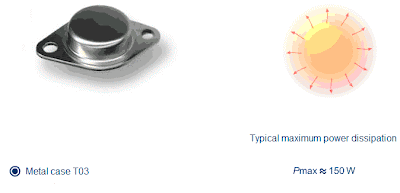Maximum Power Dissipation
High currents and voltages in power devices produce very high internal power loss. This loss occurs in the form of heat that must be dissipated; otherwise, the device can be destroyed as a result of overheating.The maximum power dissipation Pmax indicates a device's maximum capability to transfer and conduct this power loss without overheating.
The above figure compares the power dissipation of different devices. As a device type is selected, the circular area changes to show the device's maximum power dissipation. As illustrated in the figure, larger metal cases are more efficient in removing heat from the transistor.
Thermal Resistance
Thermal resistance Rthj-a indicates the ability of the device to conduct and transfer heat from the junction (with temperature Tj) to ambient (with temperature Ta). More resistance means that less heat will dissipate.The junction-to-ambient thermal resistance Rthj-a consists of two resistances: Rthj-c and Rthc-a in series. The Rthj-c is the junction-to-case thermal resistance. The Rthc-a is the case-to-ambient thermal resistance. The Rthc-a is many times higher than Rthj-c.
The above figure shows the values of Rthj-a for different packages. The particular value of each resistance depends on the type of materials and on the case size. Smaller values are typical for large metal cases.
Maximum Power Dissipation vs. Temperature
The maximum power dissipation Pmax of the transistor depends on the highest junction temperature that will not destroy the device Tjmax, the ambient temperature Ta, and the thermal resistance Rthj-a according to the equation shown in the above figure.
If the ambient temperature is less than or equal to 25°C the device reaches its maximum specified power rating. When the ambient temperature increases, the power rating decreases. If the ambient temperature Ta reaches the maximum junction temperature Tjmax, maximum power Pmax becomes zero.
Heat Sink
One way to increase the power rating of the device is to diminish the thermal resistance Rthj-a. A heat sink, which is usually a metal construction with a large surface area, is used to allow heat to dissipate to ambient more easily.When a heat sink is present, the global thermal resistance Rthj-a decreases because there are more paths available for heat dissipation. The case-to-heat-sink thermal resistance Rthc-s and the heat-sink-to-ambient thermal resistance Rths-a both facilitate heat dissipation. As a result, the power rating increases as illustrated in the above figure.






.gif)












No comments:
Post a Comment